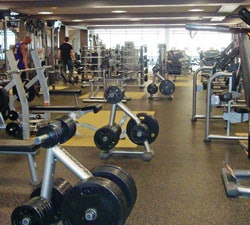So, let's say you operate a fitness facility that's about 15,000 square feet in size. You offer a little bit of everything — weights, cardio, personal training, classes of all kinds.
 Facing competition from Planet Fitness, Gold's Gym in Milwaukee converted unused floor space into a low-priced workout area.
Facing competition from Planet Fitness, Gold's Gym in Milwaukee converted unused floor space into a low-priced workout area.You're us — and you don't have the luxury of feeling pretty good. Every trend in the fitness industry is working against midsized, mid-priced clubs, and if you are not serious about adapting to this new reality, you are not going to know what hit you when it hits you.
That's our take, anyway — two guys with their boots on the ground — and apparently it's shared by the folks watching the battle from up on the ridge. Industry analyst Mary Nanfelt, for example, in an April interview with IHRSA's Club Business International, noted, "Our research shows that price-conscious consumers are choosing to join smaller facilities with fewer amenities and avoiding larger ones that tend to be more expensive. Consumers who are willing to spend more are demanding facilities that cater to a niche market or have exceptional perks. Mid-market gyms don't fit into either category." If CBI had any sense of humor, they'd have pictured Nanfelt holding a scythe. Why should we even show up for work tomorrow?
The most visible enemy of mid-priced clubs is Planet Fitness and other low-cost providers who appeal to those "price-conscious consumers." Much has been written, some of it by us, about how club owners should and should not respond to the threat posed by these low-priced gyms. Among the "shoulds" are knowing your members, differentiating yourself with offerings and services that the low-priced guys don't have, and making sure your market understands how you are differentiated. The big "should not" is: DON'T fight them on price.
The good news about the low-priced players is that there is nothing subtle about them. You can see them coming, and they shout from the rooftops when they arrive. Naturally, what they are shouting is the problem, because they reinforce the public's preconceived notion that all health clubs are the same and only worth $10 a month. If you need to counter this perception, consider the story of Lori and Jeremy Lowell, who own eight Gold's Gym franchises. When faced with competition from a Planet Fitness at their Milwaukee location, they converted unused floor space into a "low-priced" workout area. By offering a membership at just $10 a month for that workout area, they were able to get prospects in the door and then showcase their entire facility. Many of their prospects then joined for full memberships, and from media reports, they are doing just fine. Brilliant!
So, on one side you have an entire segment of our industry, with a powerful leader in Planet Fitness, telling the world that a great health club can be had for $10 a month. If that were the only trend we were fighting, it wouldn't be so bad. But, who's on the other side?
The other side is populated by players who are charging almost the same as you, or even more than you, while offering less stuff for a supposedly superior experience. They are the "niche" players, touting their "exceptional perks." Your weight room and cardio room now have to compete with Snap Fitness or Anytime Fitness, and they are open 24 hours a day, seven days a week. Your cycle room now has to compete with FlyWheel and other cycle-only studios, where the bikes are set up like stadium seating, the sound systems are world class, biofeedback is displayed for each rider on an LED screen, and every bike can be reserved online in advance. Your personal training business is now competing with every trainer who has ever wanted to start his or her own business. Businesses that do nothing but boot camps are popping up everywhere. Group fitness classes are being offered in group-fitness-only studios where classes are available at so many times each day that members feel like they are getting their own personal start time. It's the boutique-ification of fitness, allowing customers to do just what they enjoy doing, feeling like they are being catered to, and getting in and out so they can get on with their day.
What's remarkable is what these boutiques are able to charge. FlyWheel is getting $25 or more per class - per class! Granted, they are currently in major metropolitan areas where everything is more expensive, but even in our rural corner of the world, there's a nearby cycle-only studio that is charging more per month for unlimited cycling than we charge for our whole gym membership. We don't yet know whether they'll be successful, but the trend is their friend. After all, public perception is that a boutique must be better at its specialty than a general-purpose health club is, and when you're a specialist you get to charge more, whether you're a boot-camp-only training operation or a heart surgeon.
With our pool, group fitness studio, cycle studio, cardio room, weight room, Pilates room and personal training area, we often have people everywhere in our club, and it's great. But we know that only our pool is easily defensible, given that the cost and complexity of building one will likely keep our competitors pool-free. Every other service we offer could be threatened by the next one-trick pony out there. The insidious nature of this threat is that it's quiet. It's not Planet Fitness pounding on the front door with a sledgehammer and shouting, "We're here!" It's more like corrosion that gradually eats away at membership. They'll pick off our current members one at a time and, even worse, there will be prospects who will never walk through our doors because they will visit one of these other facilities first and not even check us out.
Is it going to happen tomorrow? No. Are all of these new boutique businesses going to be successful? Of course not. But it's where things are headed. Our challenge is to get ahead of the trend. That means always executing at our best. Keeping our equipment and facility shiny and new. Touching and impacting our members so they get the experience they expect with the results they deserve. Determining where we should invest to match the laser-focused offerings of these boutiques. Taking a close look at our marketing and advertising so our market understands what we offer.
In fact, that last point may be the most important. We need to communicate effectively so prospects understand what we do, how we do it and that, indeed, we do offer a compelling combination of diverse yet world-class experiences at a reasonable price. Otherwise, we're going to be too expensive to be cheap and too big to be small.

































